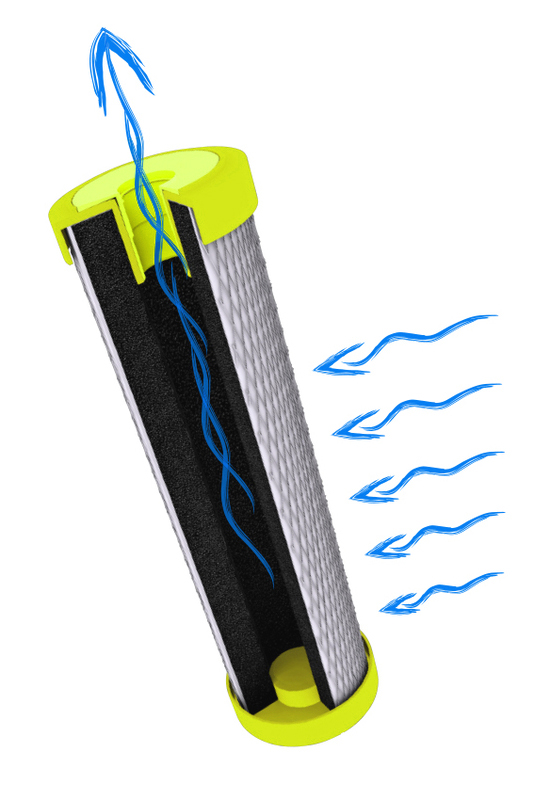The filter insert determines the quality of the filtered water. That is why we only choose high-end filter inserts that are made in Germany and are of outstanding, reliable quality.
All of the filter inserts we offer use activated carbon as a medium, the performance of which is scientifically known and ideally suited for filtering tap water.
The high-quality activated carbon is specially activated and manufactured into a solid block in a complex sintering process. The filter inserts are therefore called activated carbon block filters.
These block filters have an extraordinarily large number of extremely fine pores and channels through which the water flows during filtering. It covers a very long way and comes into intensive contact with the inner surface of the activated carbon, which is up to 100 soccer fields in size (up to 1,300 square meters per gram).
An effect that is comparable to natural depth filtration is achieved in the smallest of spaces.
One advantage of these activated carbon block filters is that dissolved minerals remain in the water and the natural mineral balance is maintained. In addition, due to the quality of the filter inserts, there is no need to add silver for disinfection.
Thanks to innovative technologies, it is possible to produce filter inserts with excellent filter performance and, at the same time, rapid water flow.
We have described the operating principle and the efficiency of activated carbon in detail in the product information “Filtering capacity of activated carbon”, which is available in the download area on the Alps Filter website.

What does an activated carbon water filter filter?
Tap water can contain many particles, substances and organisms that a high-quality activated carbon filter can hold back:
- Particles and suspended particles
- Asbestos fibers
- Bacteria
- Parasites e.g. Giardia
- Organic compounds
- Pesticides & Pesticide Residues
- Drug residues
- Lead
- Copper
- Chlorine & chlorine breakdown products
Mechanical action filters like a sieve
The mechanical retention of the activated carbon block filters is based on their filter fineness. In doing so, they hold back all particles that are larger than their pores and channels. For example: bacteria, cryptosporidium (single-cell parasites), giardia (small intestine parasites), suspended particles, microplastics, sand, rust particles and asbestos fibers.
Catalytic effect filters through conversion
The catalytic effect is a special property of activated carbon and removes, among other things, chlorine and chlorine compounds (CHCs, CFCs).
Adsorptive effect filters through absorption
The adsorptive effect the ability to attach substances to the surface) of activated carbon removes inorganic and organic substances that are also smaller than the pores and channels. For example: lead, copper, herbicides, pesticides, fungicides, hormone residues, drug residues, odor and taste impairing substances.
